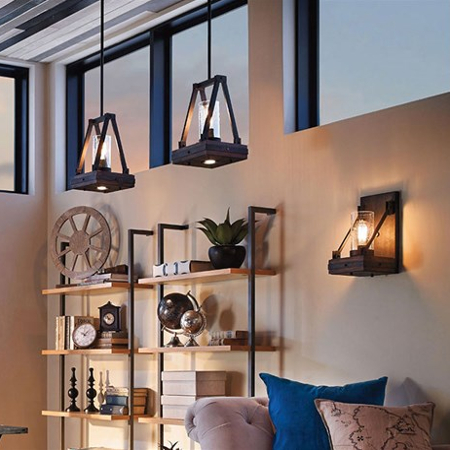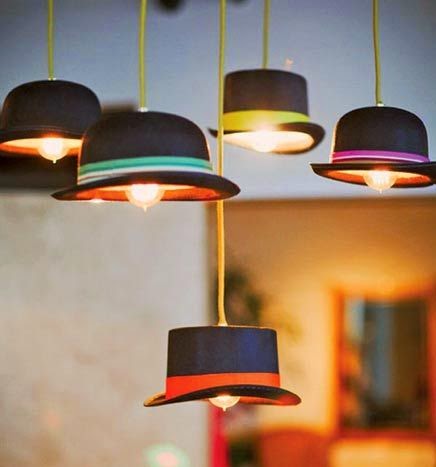Best Luxury Lighting Tips
Posted: 20 Feb 2022, 17:39
The Greatest High-End Interior Lighting Site
Lighting is one of the most important elements of an interior. Not only does it light up a room and make it appear more spacious, but it can also transform its appearance. On the one hand, it can turn a drab room into a glossy-magazine-worthy space with the simple flick of a switch or, on the other, it can under- or over-illuminate resulting in headaches, tired eyes and lighting fatigue. Albert Hadley, an American interior designer and author who once said that "design is defined by light, shade, and it is immensely significant." This article will give you expert tips on how to style lighting for your home.
Light Types
In the first place, everyone should be aware there are two types of lighting.
1. Natural Light
Sunlight is the sun's natural light source that is the most efficient. It's stimulating for the mind and is completely free. But it's also difficult to manage. The lighting will differ based on where you live. For example, north-facing light is more intense than south-facing. The amount of natural light the room gets is contingent on the season and the time of day. Window treatments can help regulate the natural light. Sara Cosgrove, interior designer is a proponent of using "sheers or window treatments" in rooms that get very little natural light. Mirrored furniture (such as the Carina cabinet for bedrooms) is also a good option and can give storage space. The use of thicker drapes can help to reduce natural light flooding into rooms. Glare is also an issue. A room that is bright can appear cold or flat. Alternative window treatments, like roman blinds louver, venetian or roman blinds, may aid in controlling the sun's rays and decrease glare. Combustion light (i.e. candles and firelights are both atmospheric sources for natural light that should not be overlooked. A fire can make this area for a chalet reception all the more welcoming. If placed at the top or the end of a mantlepiece, statuesque tapers set within elegant candlesticks/candelabra will look gorgeous. A more casual way to enjoy candlelight indoors and outdoors is with lanterns, hurricanes, and even lanterns.

2. Artificial Light
To create layers of light in your home, artificial lighting is an excellent option. A warm lighting (opposed to a clear lighting) is the most welcoming option for living spaces. Artificial lighting can be used to improve the design of an area and to create zones. It can also alter the perception of proportions. When designing your lighting scheme be sure to consider these five lighting categories. It is important to consider what you want to make use of the space and where it is best placed. After that, you are able to make use of a variety of lighting effects to get the look you want.
Here Are 5 Interior Light Types
The five main types for lighting in the interior are general (ambient, mood) as well as accent, task (task) and accent. Certain lights are able to fit in a variety of categories (depending on their placement in the room, their brightness, and how they are used) However, a broad knowledge of each type of lighting can be very helpful in planning an effective design.
A. General Lighting
General lighting forms the base of a lighting scheme. It emits an uniform glow, and also illuminates spaces for their functional purposes. The most distinctive feature of all lighting is that it's generally direct and must be controlled with the use of a dimmer to account for the variations in daylight. The most commonly used source for general lighting is the central pendant light. It could make a significant contribution to the design of the room. The eye can be directed by a beautiful chandelier or a striking fixture, which make great visual statements and are sure to draw attention. They are best complemented by other lighting. A central source of illumination, like chandeliers or an art installation, could create harsh shadows but do not bring vitality to the space. A lighting system that is easy to use is not ideal for creating a comfortable space. Check out top linear suspension lighting tips.

B. Accent Lighting
Accent lighting serves the same the function of task lighting. It is lighting that has been specifically designed to highlight certain elements within a space. Accent lighting highlights artworks, sculptures, and objets that are placed on pedestals or cabinets are a few examples. They help to enhance the artifacts and help to prevent them from being obscured in spaces that are not well-lit. Accent lighting is like task lighting, in that it demands greater lumens (light output) than task lighting. This is why it requires more power. Sometimes, architectural lighting may be used in accent lighting as well as ambient lighting. Accent architectural lighting tends be more subtle but highlights patterns and boundaries more than a specific object. Check out recommended Alora lighting Canada recommendations.
C. Ambient Lighting
The other layer of light is ambient lighting which can be a perfect complement to general lighting. Both types share important characteristics--they're primarily functional and used to light a complete area. The primary difference is in their direction of light. Interior designer April Russell explains the difference by saying "General lighting is just that -- practical lighting for daytime and night usage. Ambience lighting is connected to the dimming control system which lets you set appropriate light levels for each occasion. Ambience lighting has a general goal of creating drama and entertainment. Think about eyeballs and wall sconces as lighting fixtures that illuminate the wall. Ambient lighting is another type of lighting that is architectural. It is employed to alter the size or appearance of spaces. Without it, the space would appear dark and very confined. See the most popular outdoor lighting Canada options.

D. Task Lighting
Its name suggests that task lighting is any lighting source that is utilized for specific purposes, such as reading or cooking. In general, these lights need to be more powerful than other lighting. For eye strain, avoid using these lights with ambient light. The most important areas that require lighting for task are work and reading areas such as this Elicyon home office. The balanced-arm lamps are great for desk designs, while flexible reading lamps that are placed close to a headboard can be great for bedtime reading. Mirror lighting is ideal for bathroom areas for personal grooming and showers. To ensure food preparation is safe and less stressful tasks lighting must be integrated into the kitchen. In terms of lighting for kitchen tasks There are a variety of options. There are recessed downlights placed over the worktops, long pendant lights over the island and under-cabinet light. Task lights can also be used for creating pathways for foot traffic in a room or hallway. See the top Artemide brands.
E. Mood Lighting
General and ambient lighting can have an impact on the overall layout of a space, but mood lighting can make it appear larger. It creates a warm space by providing lighting that is more bright than the normal lighting. It's also a crucial element of a room's aesthetic since it is often conscious of style as it is with functionality. The most popular options are floor lamps and table lamps, as shown in this Parisian living room design by Jean-Louis Deniot. It is recommended to choose a console or solid side table to accommodate table lamps. It's not easy to hide the wires. Connect wires to the table by drilling a small hole, or using tape or stapleing them down to the leg. Keep plug sockets close to where your lamps will be situated--another good reason to leave your electrical planning until nearer the end of your design. The light source that is crucial to mood lighting is that close to your eyes. So, it is recommended to use a filter to reduce the glare that comes from empty bulbs. If the bulb you are using is evident from the ground, it's also essential to cover your general or ambient lighting.
Final Words
Casa Di Luce You have many options when it comes to high-end lighting. These tips above can help decide the best light fixture for you before making a choice. CasaDiLuce.ca is able to help you create the perfect atmosphere with its wide selection of light fixtures. Want to learn more? There is CasaDiLuce.ca online to shop for lighting products in Toronto.
Lighting is one of the most important elements of an interior. Not only does it light up a room and make it appear more spacious, but it can also transform its appearance. On the one hand, it can turn a drab room into a glossy-magazine-worthy space with the simple flick of a switch or, on the other, it can under- or over-illuminate resulting in headaches, tired eyes and lighting fatigue. Albert Hadley, an American interior designer and author who once said that "design is defined by light, shade, and it is immensely significant." This article will give you expert tips on how to style lighting for your home.
Light Types
In the first place, everyone should be aware there are two types of lighting.
1. Natural Light
Sunlight is the sun's natural light source that is the most efficient. It's stimulating for the mind and is completely free. But it's also difficult to manage. The lighting will differ based on where you live. For example, north-facing light is more intense than south-facing. The amount of natural light the room gets is contingent on the season and the time of day. Window treatments can help regulate the natural light. Sara Cosgrove, interior designer is a proponent of using "sheers or window treatments" in rooms that get very little natural light. Mirrored furniture (such as the Carina cabinet for bedrooms) is also a good option and can give storage space. The use of thicker drapes can help to reduce natural light flooding into rooms. Glare is also an issue. A room that is bright can appear cold or flat. Alternative window treatments, like roman blinds louver, venetian or roman blinds, may aid in controlling the sun's rays and decrease glare. Combustion light (i.e. candles and firelights are both atmospheric sources for natural light that should not be overlooked. A fire can make this area for a chalet reception all the more welcoming. If placed at the top or the end of a mantlepiece, statuesque tapers set within elegant candlesticks/candelabra will look gorgeous. A more casual way to enjoy candlelight indoors and outdoors is with lanterns, hurricanes, and even lanterns.

2. Artificial Light
To create layers of light in your home, artificial lighting is an excellent option. A warm lighting (opposed to a clear lighting) is the most welcoming option for living spaces. Artificial lighting can be used to improve the design of an area and to create zones. It can also alter the perception of proportions. When designing your lighting scheme be sure to consider these five lighting categories. It is important to consider what you want to make use of the space and where it is best placed. After that, you are able to make use of a variety of lighting effects to get the look you want.
Here Are 5 Interior Light Types
The five main types for lighting in the interior are general (ambient, mood) as well as accent, task (task) and accent. Certain lights are able to fit in a variety of categories (depending on their placement in the room, their brightness, and how they are used) However, a broad knowledge of each type of lighting can be very helpful in planning an effective design.
A. General Lighting
General lighting forms the base of a lighting scheme. It emits an uniform glow, and also illuminates spaces for their functional purposes. The most distinctive feature of all lighting is that it's generally direct and must be controlled with the use of a dimmer to account for the variations in daylight. The most commonly used source for general lighting is the central pendant light. It could make a significant contribution to the design of the room. The eye can be directed by a beautiful chandelier or a striking fixture, which make great visual statements and are sure to draw attention. They are best complemented by other lighting. A central source of illumination, like chandeliers or an art installation, could create harsh shadows but do not bring vitality to the space. A lighting system that is easy to use is not ideal for creating a comfortable space. Check out top linear suspension lighting tips.

B. Accent Lighting
Accent lighting serves the same the function of task lighting. It is lighting that has been specifically designed to highlight certain elements within a space. Accent lighting highlights artworks, sculptures, and objets that are placed on pedestals or cabinets are a few examples. They help to enhance the artifacts and help to prevent them from being obscured in spaces that are not well-lit. Accent lighting is like task lighting, in that it demands greater lumens (light output) than task lighting. This is why it requires more power. Sometimes, architectural lighting may be used in accent lighting as well as ambient lighting. Accent architectural lighting tends be more subtle but highlights patterns and boundaries more than a specific object. Check out recommended Alora lighting Canada recommendations.
C. Ambient Lighting
The other layer of light is ambient lighting which can be a perfect complement to general lighting. Both types share important characteristics--they're primarily functional and used to light a complete area. The primary difference is in their direction of light. Interior designer April Russell explains the difference by saying "General lighting is just that -- practical lighting for daytime and night usage. Ambience lighting is connected to the dimming control system which lets you set appropriate light levels for each occasion. Ambience lighting has a general goal of creating drama and entertainment. Think about eyeballs and wall sconces as lighting fixtures that illuminate the wall. Ambient lighting is another type of lighting that is architectural. It is employed to alter the size or appearance of spaces. Without it, the space would appear dark and very confined. See the most popular outdoor lighting Canada options.

D. Task Lighting
Its name suggests that task lighting is any lighting source that is utilized for specific purposes, such as reading or cooking. In general, these lights need to be more powerful than other lighting. For eye strain, avoid using these lights with ambient light. The most important areas that require lighting for task are work and reading areas such as this Elicyon home office. The balanced-arm lamps are great for desk designs, while flexible reading lamps that are placed close to a headboard can be great for bedtime reading. Mirror lighting is ideal for bathroom areas for personal grooming and showers. To ensure food preparation is safe and less stressful tasks lighting must be integrated into the kitchen. In terms of lighting for kitchen tasks There are a variety of options. There are recessed downlights placed over the worktops, long pendant lights over the island and under-cabinet light. Task lights can also be used for creating pathways for foot traffic in a room or hallway. See the top Artemide brands.
E. Mood Lighting
General and ambient lighting can have an impact on the overall layout of a space, but mood lighting can make it appear larger. It creates a warm space by providing lighting that is more bright than the normal lighting. It's also a crucial element of a room's aesthetic since it is often conscious of style as it is with functionality. The most popular options are floor lamps and table lamps, as shown in this Parisian living room design by Jean-Louis Deniot. It is recommended to choose a console or solid side table to accommodate table lamps. It's not easy to hide the wires. Connect wires to the table by drilling a small hole, or using tape or stapleing them down to the leg. Keep plug sockets close to where your lamps will be situated--another good reason to leave your electrical planning until nearer the end of your design. The light source that is crucial to mood lighting is that close to your eyes. So, it is recommended to use a filter to reduce the glare that comes from empty bulbs. If the bulb you are using is evident from the ground, it's also essential to cover your general or ambient lighting.
Final Words
Casa Di Luce You have many options when it comes to high-end lighting. These tips above can help decide the best light fixture for you before making a choice. CasaDiLuce.ca is able to help you create the perfect atmosphere with its wide selection of light fixtures. Want to learn more? There is CasaDiLuce.ca online to shop for lighting products in Toronto.